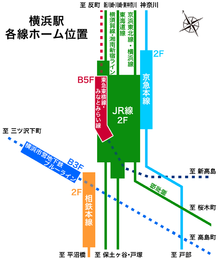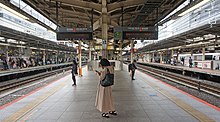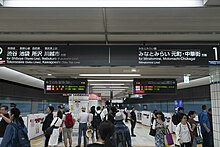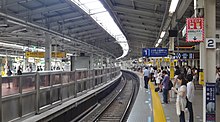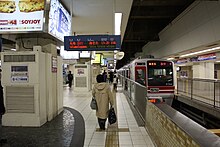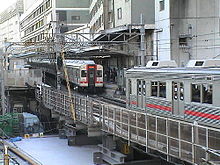Yokohama Railway Station
| Yokohama ( 横 浜 ) | |
|---|---|
|
Yokohama Railway Station, West Exit
|
|
| Data | |
| Location in the network | Junction station |
| Design |
Through station / terminus station |
| Platform tracks | 15 (railway) 2 (subway) |
| abbreviation | JT15 / JK12 / JO13 / JS13 / TY21 / MM01 / SO01 / B20 / KK37 |
| opening | October 15, 1928 |
| location | |
| City / municipality | Yokohama |
| prefecture | Kanagawa |
| Country | Japan |
| Coordinates | 35 ° 27 '57 " N , 139 ° 37' 20" E |
| Height ( SO ) | 4 m TP |
| Railway lines | |
| List of train stations in Japan | |
The Yokohama Station ( Jap. 横浜駅 , Yokohama-eki ) is a station on the Japanese island of Honshu . It is located in the area of the city Yokohama in Kanagawa Prefecture , more precisely in the district of Nishi-ku . The major hub station is operated jointly by the railway companies JR East , Keikyū , Sagami Tetsudō , Tōkyū Dentetsu and Yokohama Kōsoku Tetsudō . It is also connected to the Yokohama subway and is an important hub for bus transport. Yokohama Station has existed since 1928. Previously, Sakuragicho had been the city's main train station since Japan's first railway line opened in 1872 . A new building built in 1915 was destroyed only eight years later by the Great Kantō earthquake , whereupon the station was moved to its current location.
links
Yokohama is one of the most important junction stations in the country. Eleven railway lines from six different railway companies meet here. JR East has six routes: the Tōkaidō Main Line , Keihin-Tōhoku Line , Negishi Line , Shōnan-Shinjuku Line , Yokohama Line and Yokosuka Line . There are also the Keikyū main line of Keikyū , the Tōyoko line of the Tōkyū Dentetsu , the Sōtetsu main line of the Sagami Tetsudō , the Minatomirai line of the Yokohama Kōsoku Tetsudō and the blue line of the Yokohama subway .
The Tōkaidō main line is mainly used for accelerated commuter traffic over medium distances. Two different express trains run at frequent intervals , the Rapid Acty ( 快速 ア ク テ ィ ー , Kaisoku akutī ) and the Commuter Rapid ( 通勤 快速 , Tsūkin Kaisoku ) from Tokyo to Atami or Odawara . In addition, there are the Shōnan Liner (express trains during peak traffic with reserved seats), tourist excursion trains, the Odoriko regional express train, which runs between Tokyo and the Izu Peninsula , and the Sunrise Seto and Sunrise Izumo night trains . Most local trains, whose terminus used to be Tokyo Station, have been running on the Ueno-Tokyo Line to Ueno since 2015 . They are thereby linked to the Utsunomiya Line , the Jōban Line and the Takasaki Line in the northern part of the metropolitan area. An important express train connection is the Narita Express from Ōfuna to Narita Airport .
The Keihin-Tōhoku line coming from Ōmiya and Tokyo covers local traffic, has its own tracks and is linked in Yokohama with the Negishi line to Ōfuna. The Shōnan-Shinjuku line and the Yokosuka line also run partially parallel to the Tōkaidō main line. The former connects Utsunomiya and Maebashi in the north with Zushi and Odawara in the south, the latter is connected to the Sōbu rapid transit line starting in Chiba and leads via Yokohama to Kurihama . Another close operational link exists between the Negishi Line and the Yokohama Line , which leads to Hachiōji via Shin-Yokohama (there connection to the Tōkaidō Shinkansen ) .
On the Keikyū Main Line trains between numerous to Shinagawa in Tokyo and Uraga offered, some of which the Asakusa Line of the Tokyo subway by bound to or from the Keikyu Airport Line to Haneda Airport operate. The Minatomirai Line and the subsequent Tōyoko Line together form a connection from Motomachi-Chūkagai via Yokohama to Shibuya without having to change trains ; there is a further connection to the route network of the railway companies Tōbu Tetsudō and Seibu Tetsudō via the Fukutoshin line of the Tokyo subway . In the western suburbs of Yokohama the Sōtetsu main line leads to Ebina . The subway's Blue Line, operated by the Yokohama City Traffic Department , runs from around 5:30 a.m. to 0:30 a.m., seven to 14 times an hour, depending on the time of day.
Several bus stations make Yokohama Station the most important hub for local public transport. The one east of the station is on the first floor of the Yokohama New City Building . It is served by more than twenty local bus routes operated by the Tourist Office and the Kanagawa Chūō Kōtsuū and Keikyū Bus companies; Likewise, three dozen night lines, express buses and airport shuttle buses run from here. Numerous long-distance buses to all regions of Japan run from the Yokohama City Air Terminal , which is located on the first floor of the neighboring Yokohama Sky Building office complex . The bus station at the western exit is spread over the station forecourt and two side streets. From here, more than fifty bus routes run by the Tourist Office and the Kanagawa Chūō Kōtsuū and Sōtetsu Bus companies .
investment
In terms of design, Yokohama is a combination of three through stations and a terminus . They are located on the border between the districts of Kitasaiwai in the west and Takashima in the east, both of which are part of the Nishi-ku district . Until the end of the Edo period, the area on which the train station stands was in a shallow bay called Sodegaura, which adjoined Tokyo Bay and was drained in 1869 as part of an ambitious private land reclamation project (the district that emerged afterwards is after the for it responsible businessman named Takeshima Kaemon). Today the area is characterized by numerous high-rise buildings. To the east of the station are among other things the headquarters of Nissan , the Yokohama Sky Building, the department stores Sogō and Marui and the Minato Mirai 21 district that emerged from the conversion of earlier port facilities . To the west of this are further office buildings and universities.
The above-ground part of the system is oriented from the northeast to the southwest. In its western part, JR East has eight tracks on four completely covered central platforms , each of which offers space for trains with up to 15 cars. Access to the platforms is on the first basement floor via three spacious underpasses at the northern and southern ends and in the central area, each several hundred meters long. They are connected to one another on the second basement floor by another underpass in a northeast-southwest direction. The Keikyū tracks, which run parallel to the JR tracks, open up two tracks on two enclosed side platforms on the east side of the station ; they offer space for trains with ten cars.
In the fifth basement, below the westernmost JR tracks, there is the common by Tōkyū Dentetsu and Yokohama Kōsoku tetsudō used tunnel station . It can be reached from the underpass in the second basement and has two tracks on a central platform that are equipped with platform screen doors. The terminal station of the Sagami Tetsudō (Sōtetsu) is elevated and offset a little to the south next to the western JR tracks, on the first floor of a side wing of the reception building there. Three tracks end butt at two side and middle platforms so that boarding and alighting can be done separately ( Spanish solution ). All platforms have platform screen doors and offer space for ten-car trains. In contrast to all other parts of the station, the underground station of the Blue Line, which is oriented from northwest to southeast, is located southwest of the JR station on the third basement floor. It has two tracks on a central platform with platform screen doors and can be reached via the central main underpass.
The shopping opportunities are varied. The Yokohama Porta shopping center can be found on several levels in the underpasses on the east side . It has more than 120 stores and is owned by Yokohama New City Center , in which the Keikyū railway company has a majority stake. The eight-storey eastern entrance building contains the LUMINE Yokohama shopping center with 180 additional stores, which is owned by a subsidiary of JR East. The Joinus Yokohama at the west exit is by far the largest . It is owned by Sagami Tetsudō and comprises around 400 shops on two floors below ground and eight above ground.
In the 2018 fiscal year, an average of 1,898,066 passengers used the station every day. Of these, 423,651 went to JR East, 367,023 to Tōkyū, 327,025 to Keikyū, 429,114 to Sagami Tetsudō, 207,635 to Yokohama Kōsoku Tetsudō and 143,618 to the subway. This makes Yokohama the fifth most used train station in Japan.
Tracks
- JR East
| 3 | ▉ Negishi line | Sakuragichō • Isogo • Ōfuna |
| 4th | ▉ Keihin-Tōhoku line | Kawasaki • Tokyo • Ōmiya |
| ▉ Yokohama Line | Yokohama • Machida • Hachiōji | |
| 5/6 | ▉ Main Tōkaidō line | Odawara • Atami • Itō |
| 7/8 | ▉ Main Tōkaidō line | Kawasaki • Tokyo • Ōmiya |
| 9 | ▉ Yokosuka line | Ōfuna • Zushi • Kurihama |
| ▉ Shōnan-Shinjuku line | Ōfuna • Zushi • Fujisawa • Odawara | |
| 10 | ▉ Yokosuka line | Shinagawa • Tokyo • Chiba • Narita Airport |
| ▉ Shōnan-Shinjuku line | Shibuya • Shinjuku • Shinagawa |
- Keikyu
| 1 | ▉ Keikyū main line | Kamiōoka • Uraga • Miurakaigan |
| 2 | ▉ Keikyū main line | Keikyū Kamata • Haneda Airport • Shinagawa |
- Tōkyū Dentetsu / YKT
| 1 | ▉ Minatomirai Line | Motomachi-Chūkagai |
| 2 | ▉ Tōyoko line | Shibuya • Ikebukuro • Tokorozawa • Kawagoe |
- Sagami Tetsudo
| 1/2 | ▉ Sōtetsu main line | Futamatagawa • Shonandai • Ebina |
| 3 | ▉ Sōtetsu main line | (only to get off) |
- Subway
| 1 | ▉ Blue line | Kamiōoka • Totsuka • Shōnandai |
| 2 | ▉ Blue line | Shin-Yokohama • Azamino |
history
The first railway line in Japan, opened in 1872, ran from Tokyo to Yokohama and was part of today's Tōkaidō main line . However, the southern terminus of Yokohama was closer to the port and its location corresponded to that of today's Sakuragicho station for four decades . The commissioning of the electric Keihin line in December 1914 made it necessary to reorganize rail traffic. At what is now Takashimachō subway station , a new station called Yokohama was built, which was opened on August 15, 1915. It was on a shortcut to Hodogaya , which had already been opened in 1898 to avoid the terminus. In the Great Kanto earthquake on September 1, 1923, it collapsed and therefore had to make way for a makeshift solution.
The destroyed central station was built on a piece of land that was created through land reclamation on the shores of Tokyo Bay . The site was now considered too unstable, so the Ministry of Railways decided to build a new building at the current location. On May 18, 1928, the private railway company Tōkyū Dentetsu extended the Tōyoko line from the previous terminus at Kanagawa to Takashimachō. This section of the route led through the major construction site for five months. Finally, on October 15 of the same year, the new main station opened. The electric suburban trains of the Keikyū , whose terminus had previously been the neighboring Kanagawa station, stopped from June 22, 1929 at a temporary platform in Yokohama station. The definitive platform went into operation on February 5, 1930, the southern continuation of the Keikyū main line to Koganechō on December 26, 1931. The Jinchū Tetsudō , a predecessor of the Sagami Tetsudō , extended the Sōtetsu main line from Futamatagawa to on December 27, 1933 here.
An air raid on Yokohama by the United States Army Air Forces on May 29, 1945 led to the destruction of a large part of the railway systems, which then had to be gradually restored. From 1959 to 1972 a trolleybus connected the station with the city center. The Yokohama City Traffic Office opened on September 4, 1976 a section of the Blue Line of the Yokohama subway between Isezaki-Chōjamachi and Yokohama Station, followed by the extension to Shin-Yokohama Station on March 14, 1985 . The Tōkaidō main line and the Yokosuka line received separate platforms on October 1, 1980, and on November 7, 1980, the Japanese State Railways opened a new station building on the east side after several years of construction. On November 1, 1986, she stopped checking in for cost reasons. As part of the privatization of the state railway, the previously state-administered part of the station was transferred to the new company JR East on April 1, 1987 .
On April 19, 1995, an incident occurred in Yokohama Railway Station in which large amounts of phosgene were released. Since this happened just a month after the sarin attack on the Tokyo subway , the authorities initially suspected a connection with the Ōmu Shinrikyō sect . A total of 668 people had to receive medical treatment, but there were no deaths. A 31-year-old man was responsible for opening a bottle of legally available self-defense spray. On January 30, 2004 Tōkyū Dentetsu put the Yokohama – Sakuragichō section of the Tōyoko line still. Instead, she began directing trains to the newly opened Minatomirai Line two days later . The city administration had the Tōkyū Viaduct, which is no longer needed, redesigned into an urban green area and opened it to the public between 2006 and 2011 as the Tōyoko Flower Green Road .
Adjacent train stations
|
←
|
Lines |
→
|
||
|---|---|---|---|---|
| Kawasaki |
JR East |
Totsuka | ||
| Higashi-Kanagawa |
JR East |
The End | ||
| Beginning |
|
Sakuragicho | ||
| Shin-Kawasaki |
JR East |
Hodogaya | ||
| Tammachi |
Tōkyū Dentetsu |
The End | ||
| Beginning |
Yokohama Kōsoku Tetsudō |
The End | ||
| Kanagawa |
Keikyū |
To be | ||
| Beginning |
Sōtetsu |
Hiranumabashi | ||
| Mitsuzawa-Shimocho |
|
Takashimacho | ||
Web links
- JR East Station Information (Japanese)
- Tokyo Station Information (Japanese)
- Keikyu Station Information (Japanese)
- Station information of Sagami Tetsudō (Japanese)
- Yokohama Subway Station Information (Japanese)
Individual evidence
- ↑ a b c JR 時刻表 2019 年 3 月 号 (JR timetable March 2019). Kōtsū shinbunsha, Tokyo 2019.
- ^ Ueno Tokyo Line opens for service, helping commuters to the north. The Japan Times , March 15, 2015, accessed May 31, 2020 .
- ^ Dan Free: Early Japanese Railways 1853-1914: Engineering Triumphs That Transformed Meiji-era Japan . Turtle Publishing, Clarendon 2014, ISBN 978-4-8053-1290-2 , pp. 63 .
- ^ Yokohama Station East Exit Underground Shopping Center. Yokohama New City Center, 2020, accessed May 31, 2020 .
- ↑ LUMINE Yokohama. Lumine Co. Ltd., 2020, accessed May 31, 2020 .
- ↑ Information. JOINUS Yokohama, 2020, accessed May 31, 2020 .
- ↑ 各 駅 の 乗車 人員. JR East , 2018, accessed May 31, 2020 (Japanese).
- ↑ 2019 年度 乗 降 人員. Tōkyū Dentetsu , 2019, accessed May 31, 2020 (Japanese).
- ↑ 京 急 グ ル ー プ 会 社 要 覧 2019–2020. (PDF; 18.1 MB) Keikyū , 2020, accessed on May 31, 2020 (Japanese).
- ↑ 1 日 平均 各 駅 乗 降 人員. Sagami Tetsudō , 2018, accessed May 31, 2020 (Japanese).
- ↑ 1 日 あ た り の 各 駅 の 乗 降 人員. Yokohama Kōsoku Tetsudō, 2018, accessed May 31, 2020 (Japanese).
- ↑ 横 浜 市 統計 書 第 9 章 道路 、 運輸 及 び 通信. Yokohama City, May 12, 2020, accessed May 31, 2020 (Japanese).
- ↑ a b c d e 横 浜 の 鉄 道: そ の 歴 史 . In: 調査 季報 . tape 121 . Yokohama City Council, Yokohama 1994, p. 44-52 .
- ↑ 旧 横 浜 駅 (3 代) の 松 杭 撤去 . In: Tetsudō Kenchiku News . No. 369 . Japanese Railway Association, Tokyo 1980, p. 30-34 .
- ↑ Masashi Nakamura: 週刊 私 鉄 全 駅 ・ 全 車 両 基地 No.10 京 浜 急 行 電 鉄 ① . Asahi Shimbun-sha, Osaka 2014, p. 29 .
- ↑ Yokohama. urbanrail.net, 2011, accessed on May 31, 2020 (English).
- ^ Richard Lloyd Parry: Japanese shaken by new gas attack. The Independent , April 20, 1995, accessed May 31, 2020 .
- ↑ 横 浜 駅 異臭 事件 、 男 を 傷害 容 疑 で 逮捕 刺激 臭 は 市 販 の 護身 ス プ レ ー. In: Asahi Shimbun , July 7, 1995.
- ↑ 東 横線 と み な と み ら い 21 線 と の 相互 直通 運 転 開始 に 伴 う 東 横線 横 横 浜 〜 桜 木 町 間 の 廃 止 に つ い て. (PDF, 18 kB) Tōkyū Dentetsu, January 30, 2003, archived from the original on April 14, 2015 ; Retrieved May 31, 2020 (Japanese).
- ↑ 東 急 東 横線 の 跡 地 利用. Yokohama City, March 14, 2019, accessed May 31, 2020 (Japanese).

